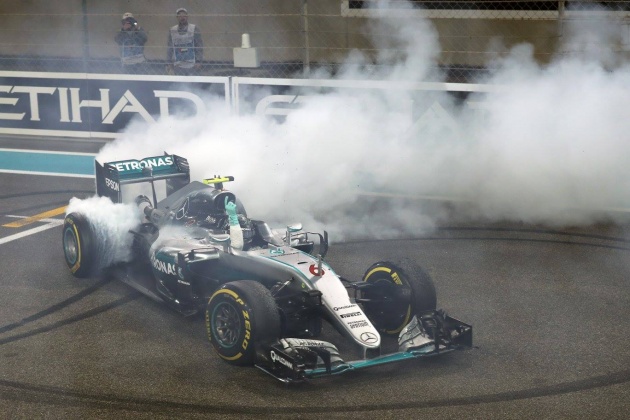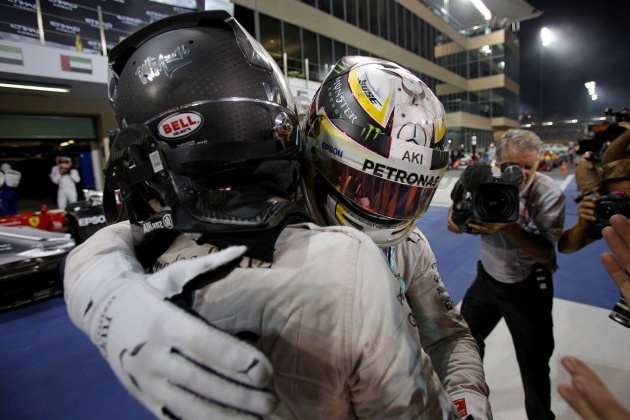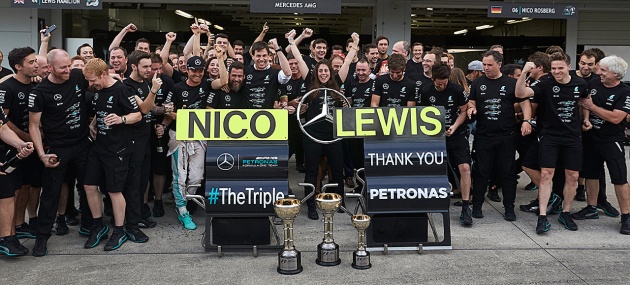He’s done it! Nico Rosberg has won the 2016 Formula 1 Driver’s Championship, making it three for three for the Mercedes-AMG PETRONAS F1 Team in the latest V6 hybrid era.
His very first driver’s title, beating teammate Lewis Hamilton – who won the previous two with the Mercedes-AMG PETRONAS F1 Team – was delivered in outstanding fashion after an exciting end to the 2016 F1 season in Abu Dhabi last weekend. It has been a long time coming, but it is now done – Nico is the world champion!
The numbers tell quite a story. He won nine races over the season, his biggest haul so far in eleven years of racing in F1. He took it all in steps – he scored his first race victory in 2012, won two more in 2013, before the Mercedes-AMG PETRONAS F1 Team stepped up its game considerably in 2014.
Nico Rosberg topped the podium five times in the first year of the V6 hybrid era, and a further six times in 2015. This year, he took nine wins and 16 podiums over 21 races to claim the title, ending the triumphant year with 385 championship points – the most ever amassed by any F1 driver over one season.
Amazingly, he achieved his 23 wins (now more than Mika Hakkinen, Kimi Raikkonen, Stirling Moss and Jenson Button) and all but one of his 57 podium finishes wearing Mercedes-AMG PETRONAS colours. Loyalty has certainly paid off for the 31-year-old German, who has been with the team from the very beginning in 2010.
Look further into the numbers and it gets even more captivating. Nico Rosberg’s 2016 championship came 34 years after his father Keke Rosberg’s 1982 title. That made him only the second son of a champion to take the title himself, after the previous father-son champions Graham and Damon Hill. The gap between the Hills’ first titles? Exactly 34 years (1962 and 1996). Uncanny.
Both sons, Nico and Damon, also managed to qualify in first or second positions in every single race of their championship seasons. Speaking of qualifying, Nico achieved eight pole positions in 2016, for a career total of 30, all with the Mercedes-AMG PETRONAS team.
Since the start of the V6 hybrid era in 2014 – the biggest regulation change ever introduced in Formula 1 – the Mercedes-AMG PETRONAS F1 team has thoroughly dominated the field. Between Nico Rosberg and Lewis Hamilton, the team has won 53 out of 61 races in the past three seasons, marking the most dominant F1 campaign ever recorded in the sport.
In fact, Mercedes-AMG PETRONAS team’s dominance over the seasons improved year-on-year, which is unprecedented. When discussing dominant f1 teams, one will surely bring up the usual suspects: Williams in 1992 (10 wins in 16 races) and 1996 (12 out of 16), Ferrari in 2002 (15 out of 17) and 2004 (15 out of 18) and of course, McLaren in 1988 (15 out of 16).
Mercedes-AMG PETRONAS, though, beat all of them three years on the trot, winning 16 races out of 19 rounds in 2014 and 2015, and 19 out of 21 in 2016. In 2015, in fact, the team recorded 12 one-two finishes in the season, an all-time record.
Other records broken by the Mercedes-AMG PETRONAS team include the most podiums in a season (31 in 2014, 32 in 2015 and 33 in 2016, all record highs) – all but one race in 2016 featured at least one Mercedes-AMG PETRONAS driver on the podium – and the most pole positions (18 out of 19 in 2014 and 2015, and 20 out of 21 in 2016).
With such unprecedented achievements, to say that the Mercedes-AMG PETRONAS F1 Team is the class of the field would be an understatement. It truly towered above the competition, a remarkable feat given the ultra competitive and high-tech nature of the sport.
Providing a solid backbone to the success is the team’s title and technical partner, PETRONAS. Oft times, the glamour and flamboyance of the sport have tended to eclipse the work done by a seemingly introverted team of technical minds behind the scenes. There is a lot of work being done by one group of technological minds that are pushed to the very limits at every single race.
When the 2014 season was in its infancy, there was significant chatter about Formula 1’s latest evolutionary cycle, egged on by the raft of regulation changes enforced. The Silver Arrows ultimately emerged as the front-runners, providing positive results to the work being done in Brixworth (Mercedes-AMG HPP) and in Villestellone, Italy and Kuala Lumpur (PETRONAS tech teams).
While the primary consideration of performance remained paramount to a Formula 1 team, the heavy restrictions, particularly those imposed on the sport from 2014, forced teams to be especially vigilant in ensuring that that powertrain is both reliable and robust. Of these, the areas that have drawn considerable attention were the engines and gearboxes.
The era of the 3.0 litre V12 monsters or the V8s of yesteryears have been entombed into the history books, with teams now using much smaller power units. The hybrid 1.6 litre V6 turbo engines – while being technically more advanced, complex and far superior to their road-going relatives – resonate closer to engines you and I drive on public roads, which is crucial to PETRONAS.
The challenge was to supply and control all that power (in excess of 850 hp) and torque up to the driver through the gearbox efficiently and effectively. This intensified the focus on the core contributing components, in this case the fuel, engine lubricants and gearbox oils.
With regulatory restrictions in place on fuel flow rates and race fuel loads, the development work on lubricants and oils was increasingly critical in contributing to performance gains; directly influencing both the pace and real lap time performance.
Where the overall concern is on reliability, to PETRONAS this intensified the attention on endurance and durability, and ultimately the role that lubricants and oils play in powering and protecting the engines and gearboxes.
This means PETRONAS had to design and develop engine lubricants and oils that can withstand colossal forces many times greater than gravity and much higher loads. It is fair to say that in no prior F1 eras have fuels and lubricants played a more significant role in the performance of the cars.
Seeing how it all turned out, it has been an incredible achievement by PETRONAS, proving its pool of talent and ability to design and produce what has been described as the Mercedes-AMG PETRONAS F1 Team’s winning formula.
“The demands on the F1 lubricants and oils are quite similar to that of road-going cars, more so than with fuels,” said Andy Cowell, managing director at Mercedes AMG High Performance Powertrains. For PETRONAS, the lessons learnt in Formula 1 are directly transferred to the company’s road-going products, such as PETRONAS Primax fuels, PETRONAS Syntium lubricants and PETRONAS Tutela oils.
This is epitomised through PETRONAS’ exclusive first fill engine oil arrangement for Mercedes-AMG’s A 45, CLA 45 and GLA 45 models.
In a nutshell, the same technical expertise that delivered the fuel and lubricants used to power Nico Rosberg and Lewis Hamilton’s race cars to three world championship titles back-to-back, is already being put into practice in delivering the fuel and lubricants that are available to the Malaysian consumers.
Leveraging on Formula 1 as its ultimate test bench, PETRONAS’ scientific team used the same approach in developing customised fluid solutions in extreme and demanding situations to engineer technologically superior fuels, lubricants and oils for road going cars. Ultimately, the same concerns apply – maximising engine power, efficiency and durability whilst reducing fuel consumption.
So there you go – the winning formula, which powered the Mercedes-AMG PETRONAS F1 Team and Nico Rosberg to championship victories, delivered from track to road for everyone to experience. In the end, everyone wins.








